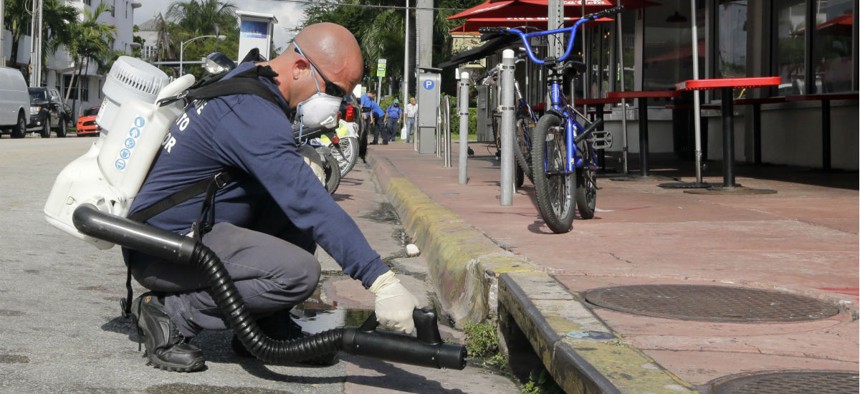Miami Beach Presents a Challenge for CDC's Zika-Fighting Efforts
Luxury high-rises in Florida's cities are making it harder for authorities to fight disease-spreading mosquitoes.
Haphazard urbanization in some of the world’s fastest-growing cities set the stage for Zika’s spread. Aedes aegypti, the mosquito that bears the virus, thrives among humans, and it has found particularly hospitable breeding grounds in the exposed trash, sunken streets, and ad hoc water storage systems of Latin American slums. Inaccessible roads in those same places have posed a problem to insecticide-sprayers attempting to cover every vulnerable corner.
Since the disease emerged in Brazil in May 2015, 45 countries have confirmed examples of local, mosquito-borne Zika transmission, mostly in South America and the Caribbean. In many of these countries, the number of cases have started to trend downwards over the past month. But in the United States, the area of transmission is expanding. In Florida, thirty-five locally acquired cases have been counted there by the Centers for Disease Control and Preventions so far, with two areas in Miami-Dade County identified by the CDC as transmission hot spots. (Although nearly 2,000 of cases of infection resulting from travel and as a handful from sexual intercourse have been reported around the U.S., no other state has documented local transmission yet.) And now another form of urban development is challenging efforts to combat Zika: luxury high-rises.
The easiest way to treat large swaths of populated land is by air: Small, low-flying aircrafts spray insecticide onto large swaths of populated areas, often late in the evening after winds have died down. Not only do Miami Beach’s signature sparkling towers physically impede these planes, but they also create wind tunnels, making it harder for insecticide to settle onto targeted areas, as National Geographic reported in August.
Thomas Frieden, the director of the Centers for Disease Control and Prevention, acknowledged this problem when he declared Miami Beach an area of special concern in mid-August. “The inability to use aerial spraying there means that we'll be restricted to ground-based technologies like backpack spraying,” he said. That tactic can only cover relatively small areas, though. As in Brazil’s favelas, backpack sprayers in Miami have to search on foot for mosquito hangouts, which can be as tiny and unassuming as a few drops of water in a bottle cap.
In Wynwood, an arts district north of downtown Miami, aerial treatments have substantially reduced mosquito populations, according to Frieden. In addition to doing aerial spraying where possible in Miami Beach, local county contractors are also starting to roll out specialized turbine trucks to spray the city’s streets in sections. These trucks are supposed to be more effective than backpacks.
But Zika will remain a tough nut to crack in dense, tourist-thronged cities like Miami, which boasts lots of people, lots of turnover among those people, and lots of exposed skin. Plus, Aedes aegypti is a wily insect: When exposed to certain insecticides, populations of mosquitos are more likely to develop resistance to them. Not only does aerial spraying cover more ground than street-level technologies, but it also deploys a much more powerful insecticide called Naled, to which mosquitos have not yet shown themselves to ber esistant. (Though the CDC and the EPA insist that it’s safe, use of the chemical has provoked controversy in some Miami neighborhoods, and the practice of blanketing some of the richest real estate in the country with potent insecticides will likely continue to draw louder and more visible protests than Brazil ever saw.)
It also doesn’t help that the U.S. is lacking a unified campaign to combat Zika.Other than a bare-bones crew of CDC workers mapping Zika-carrying mosquitos in the Miami area, there’s been very little federal manpower devoted to stemming infection risk. Miami’s assistant city manager, Nzeribe Ihekwaba, told Bloomberg last week: “This is a public health crisis, not a local problem,” he says. “We need more help. From the feds, there has to be more.”
Alas, the last session of Congress yielded nothing but gridlock in funding abatement efforts and research into new insecticides and vaccines. Lawmakers are holding a procedural vote on Zika funding Tuesday, the first day of Congress’ short fall session. But until their talk turns into action, the responsibility of protecting public health will continue to rest largely on cities and states—a responsibility that seems primed to grow. Especially after a summer of historic flooding, Zika-bearing mosquitos may well find that the Gulf Coast makes a hospitable new home.
"I would not be surprised at all if we saw individual cases and perhaps even some clusters arise in other areas of Florida as well as in other of the Gulf Coast states," Anthony Fauci, the director of the National Institute of Allergy and Infectious Diseases, told CNBC in late August. "There certainly is that possibility. That would not surprise us because the conditions are there for that to happen."
NEXT STORY: When Hillary Clinton Coughs



